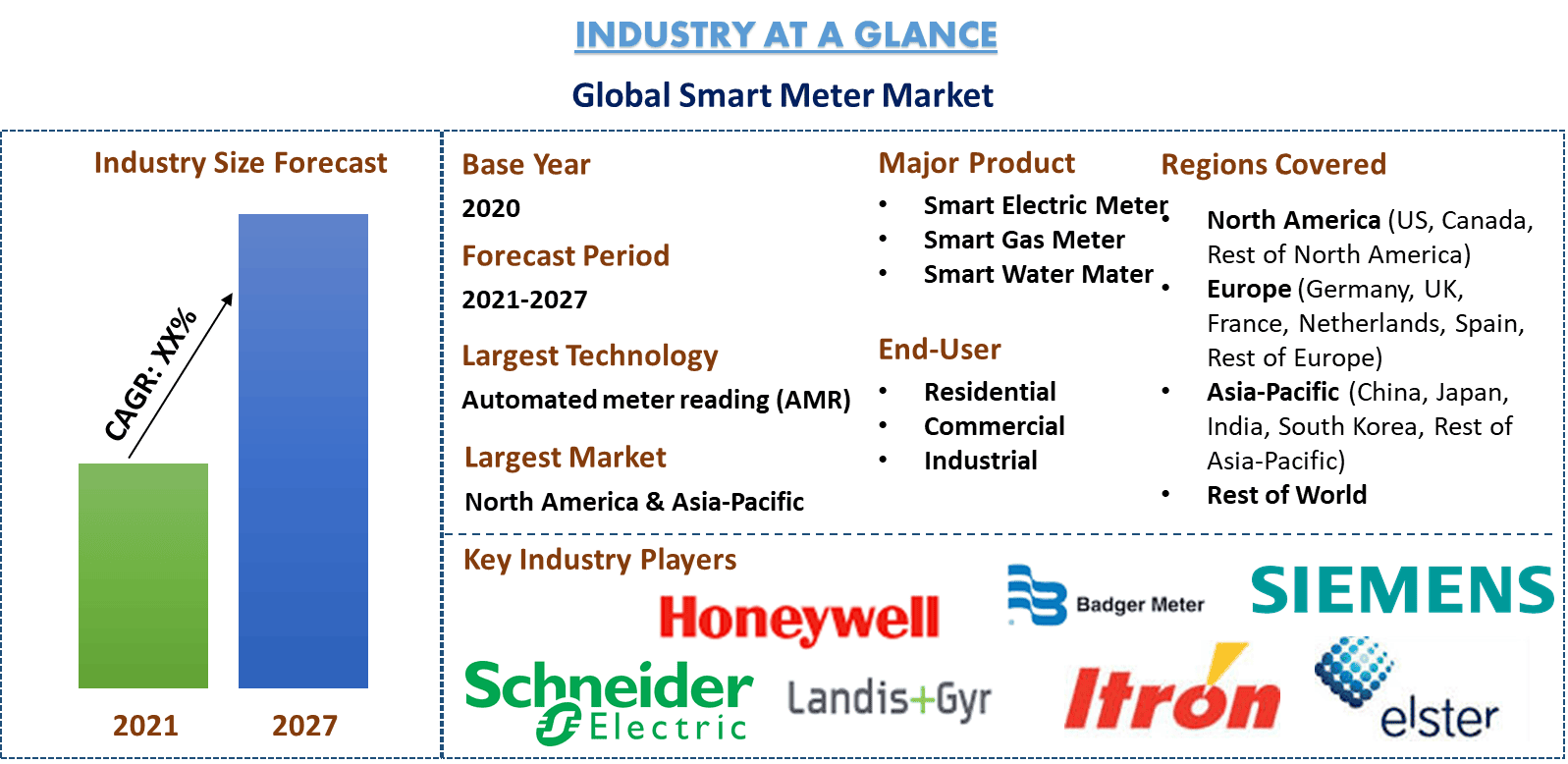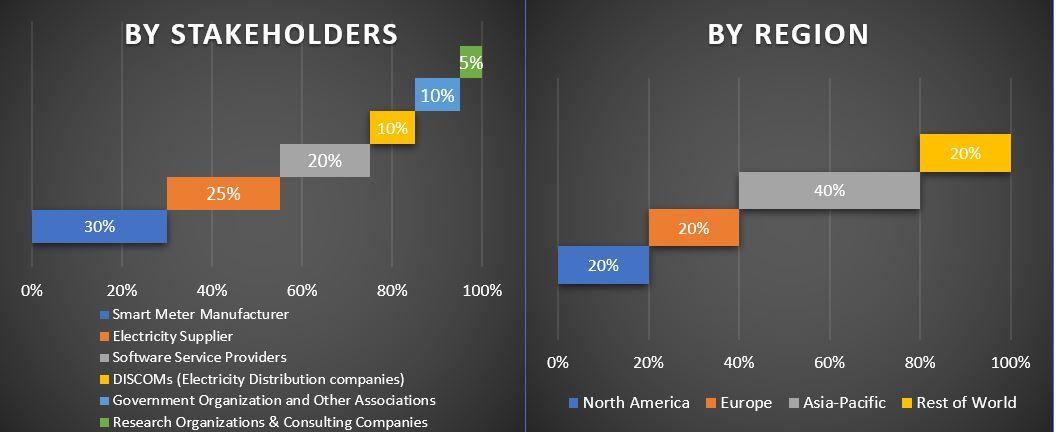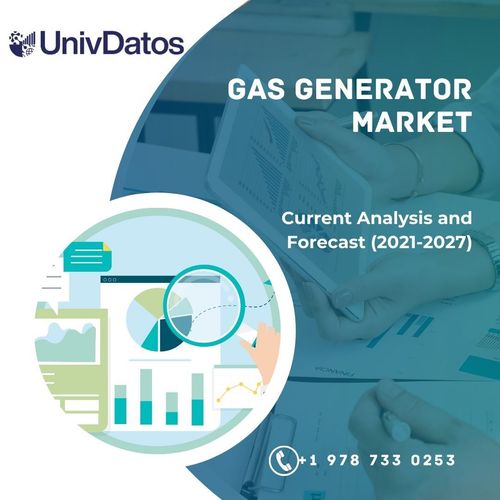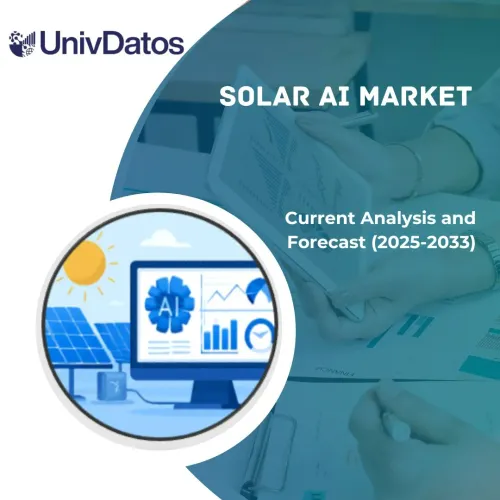- Home
- About Us
- Industry
- Services
- Reading
- Contact Us
Smart Meter Market: Current Analysis and Forecast (2021-2027)
Emphasis on Technology (Automated Meter Reading (AMR), Advanced Metering Infrastructure (AMI)); Type (Smart Electric Meter, Smart Gas Meter, Smart Water Mater); Communication Technology (Power line communication, Radiofrequency electromagnetic radiation (RF), Cellular communication); Component (Hardware, Software); End-User (Residential, Commercial, Industrial); Region and Country

Global Smart Meter Market is expected to reach US$ 40.6 billion by 2027, experiencing a CAGR of 7.1% during the forecast period 2021-2027. Globally the market for Smart Meter was US$ 24.6 billion in 2020. Machine to Machine (M2M) technology is all set to fundamentally renovate almost every aspect of business and society, supporting the shift to a more sustainable economy. Next generation utility meters or Smart Meters is a good example of such transformative potential of M2M technology. Smart Metering solutions would empower consumers by providing them feedback on their energy usage, would helping them in monitoring, managing and ultimately reducing their energy consumption and bill. Smart meter rollouts are predominantly driven by governmental support and subsidies, are further driven by the increasing demand for improved billing accuracy and curb non-technical losses. The European Commission DG Energy has estimated a total investment of €18.8 billion (US$ 22.1 billion) would be required to achieve the 2020 target. Also, the institution has estimated an investment requirement of €40.7 billion (US$ 47.9 billion) by 2030 to install/deploy 266 million smart meters in the European Union. Furthermore, at the end of 2018, there were 86 million smart meters installed throughout the US, compared to 1,190 smart meters installed globally.
Number of Smart Meter Worldwide, 2014-2020 (Unit Million)

Covid-19 pandemic have impacted all section of the society and industry and Smart Meter market is no exception. The global demand for Smart Meter decreased in 2020 and is expected to witness the same trend in the first half of FY2021. Temporarily postponed meter installations due to Covid-19 had a slightly negative impact on shipment levels in 2020, also the total number of smart meters installed in 2020, declined by 10% compared to the previous year 2019. Annual smart electricity meter shipments amounted to 20.9 million units in 2019 and the corresponding figure for Smart Gas Meters was 8.5 million units.
Insights Presented in the Report
“Amongst technology, Automated Meter Reading (AMR) segment dominated the market in 2020.”
Based on technology the global smart meter market is bifurcated into Automated Meter Reading (AMR) and Advanced Metering Infrastructure (AMI). Currently, Automated Meter Reading (AMR) segment dominate the market and is expected to maintain its dominance during the forecast period. As pe EIA, US electric utilities had more than 94.8 million advanced (smart) metering infrastructure (AMI) installed as of 2019. About 88% of all AMI installed were among residential end-users
“Amongst type, Smart Electric Meter segment dominated the market in 2020.”
Based on type the global smart meter market is segmented into Smart Electric Meter, Smart Gas Meter, Smart Water Mater. In 2020, Smart Electric Meter segment dominated the market. In 2018, globally, the installed base of smart electricity, gas and water meters stood at 1,190 million and the number is expected to reach 1,645 million by the end of 2020.
“Amongst communication technology, Cellular communication is expected to witness high growth, owing to increased smartphone penetration.”
Based on communication technology the market is divided into Power line communication, Radiofrequency electromagnetic radiation (RF), Cellular communication. Growing adoption of IoT has increased digitalization across several industries, such as gas and electricity, at an enormous rate. IoT communication networks have enabled the grid operators and DISCOMS to provide modern-day energy services.
“Amongst Component, Hardware segment generated highest revenue in 2020.”
Based on component, the market is bifurcated into Hardware and software component. Hardware segment dominated the market in 2020. Smart Meter manufactures are focusing more on reducing the hardware component with high level of system integration and simplifying design, this would further accelerate the market growth. For instance, in 2017, Diehl Metering partnered with NEC Europe to integrate metering systems in its Smart City Platform (CCOC).
“Amongst End-user, residential sector deployed maximum number of Smart Meter in 2020.”
Based on end-user the market is bifurcated into residential, commercial, and industrial end-users. Currently residential segment dominates the market and is expected to maintain its dominance during the analyzed period. Developing countries in the North America and European region are deploying Smart Meter on large scale in the households, this would further drive the market for residential Smart Meter. Number of AMI installations by sector, 2019 in the US stood at 94,838,855. Among which residential with 83,539,594 installations dominated the market, followed by commercial (10,850,886); industrial sector (446,871) and transportation sector (1,504).
“Asia-Pacific represents as the largest markets in the Global Smart Meter Market.”
For a better understanding of the market adoption, report provide detailed analysis for major region and countries including North America (US, Canada, Rest of North America), Europe (Germany, France, Netherlands, Spain, United Kingdom, Rest of Europe), Asia-Pacific (China, Japan, India, South Korea, and Rest of APAC), and Rest of World. North America and Asia-Pacific (Specifically China) would be the top two market for smart metering solutions, owing to proactive deployment of smart grid solutions in countries such as US, India, and China. Europe has emerged as a major hub for smart meter, providing ample growth opportunities for the manufacturers, as smart metering is mandatory in the UK and across Europe. Furthermore, over the forecast period, emerging markets in the MEA region are estimated to be at the forefront of smart meters deployment as a reliable source of energy supply & management.
Reasons to buy this report:
- The study includes market sizing and forecasting analysis validated by authenticated key industry experts
- The report presents a quick review of overall industry performance at one glance
- The report covers in-depth analysis of prominent industry peers with a primary focus on key business financials, product portfolio, expansion strategies, and recent developments
- Detailed examination of drivers, restraints, key trends, and opportunities prevailing in the industry
- The study comprehensively covers the market across different segments
- Deep dive country level analysis of the industry
Customization Options:
The Global Smart Meter Market can further be customized as per the requirement or any other market segment. Besides this, UMI understands that you may have your own business needs, hence feel free to connect with us to get a report that completely suits your requirements.
Table of Content
Analyzing the historical market, estimation of the current market, and forecasting the future of the Global Smart Meter Market were the three major steps undertaken to create and analyze the adoption of Smart Metering solutions across various end-user sector globally. Exhaustive secondary research was conducted to collect the historical market numbers and estimate the current market size. Secondly, to validate these insights, numerous findings and assumptions were taken into consideration. Moreover, exhaustive primary interviews were also conducted, with industry experts across the value chain of the global Smart Meter industry. Post assumption and validation of market numbers through primary interviews, we employed a bottom-up approach to forecast the complete market size. Thereafter, market breakdown and data triangulation methods were adopted to estimate and analyze the market size of segments and sub-segments the industry pertains to. Detailed methodology is explained below:
Analysis of Historical Market Size
Step 1: In-Depth Study of Secondary Sources:
Detail secondary study was conducted to obtain the historical market size of the Smart Meter through company internal sources such as annual report & financial statements, performance presentations, press releases, etc., and external sources including journals, news & articles, government publications, competitor publications, sector reports, third-party database, and other credible publications.
Step 2: Market Segmentation:
After obtaining the historical market size of the Smart Meter market, we conducted a detailed secondary analysis to gather historical market insights and share for different segments & sub-segments for major regions. Major segments included in the report as technology, type, communication technology, component, end-user. Further regional and country-level analyses were conducted to evaluate the overall adoption of the Smart Meter globally.
Step 3: Factor Analysis:
After acquiring the historical market size of different segments and sub-segments, we conducted a detailed factor analysis to estimate the current market size of Smart Meter. Further, we conducted factor analysis using dependent and independent variables such as growth of penetration of Smart Metering solutions across different end-users, digitalizing of power sector etc. A thorough analysis was conducted for demand and supply-side scenario considering top partnerships, merger and acquisition, business expansion, and product launches in the Smart Meter industry.
Current Market Size Estimate & Forecast
Current Market Sizing: Based on actionable insights from the above 3 steps, we arrived at the current market size, key players in the Global Smart Meter market, and market shares of the segments. All the required percentage shares split, and market breakdowns were determined using the above-mentioned secondary approach and were verified through primary interviews.
Estimation & Forecasting: For market estimation and forecast, weights were assigned to different factors including drivers & trends, restraints, and opportunities available for the stakeholders. After analyzing these factors, relevant forecasting techniques i.e., bottom-up approach was applied to arrive at the market forecast to 2027 for different segments and subsegments across the major regions globally. The research methodology adopted to estimate the market size encompasses:
- The industry’s market size, in terms of value (US$) and the adoption rate of Smart Meter across the major markets
- All percentage shares, splits, and breakdowns of market segments and sub-segments
- Key players in the Smart Meter market in terms of services offered. Also, the growth strategies adopted by these players to compete in the fast-growing market.
Market Size and Share Validation
Primary Research: In-depth interviews were conducted with the Key Opinion Leaders (KOLs) including Top Level Executives (CXO/VPs, Sales Head, Marketing Head, Operational Head, and Regional Head, Country Head, etc.) across major regions. Primary research findings were then summarized, and statistical analysis was performed to prove the stated hypothesis. Inputs from primary research were consolidated with secondary findings, hence turning information into actionable insights.
Split of Primary Participants in Different Regions
Market Engineering
Data triangulation technique was employed to complete the overall market estimation and to arrive at precise statistical numbers of each segment and sub-segment of the Global Smart Meter market. Data was split into several segments & sub-segments post studying various parameters and trends in the areas of technology, type, communication technology, component, end-user.
The main objective of the Smart Meter Market Study
The current & future market trends of Global Smart Meter were pinpointed in the study. Investors can gain strategic insights to base their discretion for investments from the qualitative and quantitative analysis performed in the study. Current and future market trends were determined the overall attractiveness of the market at a country level, providing a platform for the industrial participant to exploit the untapped market to benefit as a first-mover advantage. Other quantitative goals of the studies include:
- Analyze the current and forecast market size of Smart Meter in terms of value (US$). Also, analyze the current and forecast market size of different segments and sub-segments
- Segments in the study include areas of technology, type, communication technology, component, and end-user
- Defined analysis of the regulatory framework for the Smart Meter industry
- Analyze the value chain involved with the presence of various intermediaries, along with analyzing customer and competitor behaviors of the industry
- Analyze the current and forecast market size of the Smart Meter for the major countries
- Major regions/countries analyzed in the report includes North America (US, Canada, Rest of North America), Europe (Germany, UK, France, Netherlands, Spain, Rest of Europe), Asia-Pacific (China, Japan, India, South Korea, Rest of Asia-Pacific), Rest of World
- Company profiles of the Smart Meter market players and the growth strategies adopted by them to sustain in the fast-growing market
- Deep dive country level analysis of the industry
Related Reports
Customers who bought this item also bought











